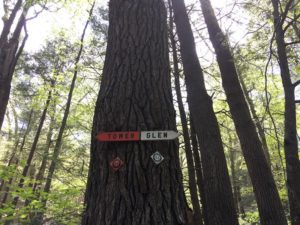Who is a member?
Our members are the local governments of Massachusetts and their elected and appointed leadership.
MMA Innovation Award winner, From The Beacon, February 2023

Stockbridge relied on tree experts and GPS mapping to help protect old-growth trees in the Ice Glen forest from invasive pests. (Photo courtesy Patrick White)
When the town of Stockbridge learned in 2021 that its beloved, centuries-old hemlock and ash trees faced death within the next few years, officials and residents sprung into action to save the oldest trees in the Ice Glen forest and preserve a piece of local and literary history.
With invasive insects threatening 300- and 400-year-old trees in the town-owned, 63-acre Ice Glen Forest, the town worked with tree experts, used GPS technology to map about 450 trees, amassed funding, and developed a plan within two months to protect the trees. The town has managed to save all of the ash trees it has treated, and many of its old hemlocks.
Ice Glen is one of the largest old-growth forests left in Massachusetts, according to Select Board Chair Patrick White. Due to its steep ravine, Ice Glen escaped the clear-cutting that took down older forests during the 19th century. The forest also holds literary and historical significance. Author Herman Mellville, who once lived nearby in Pittsfield in the mid-19th century, reminisced about “Icy Glen” in the novel “Moby-Dick,” and had given another literary giant a tour of the woods.
“This is a big part of Berkshire history,” White said. “These trees were there when the missionaries first met the Mohicans in 1734. These trees were there when Herman Melville was walking the forest with Nathaniel Hawthorne. And these trees are still here. And I think if we can save them from what is likely human impacts, then it’s a worthwhile cause.”
In early 2021, White invited two tree experts to tour the forest, after hearing about the migration of invasive insects. The rise in temperatures over the past couple of decades have caused the hemlock wooly adelgid and the black scale beetle to travel, he said. The trees also face other threats, including an ash borer.
After the experts examined the trees, they offered a sobering diagnosis: Stockbridge would lose many of its old-growth trees within the next two or three years if it didn’t act.
“It turned out to be in much more dire condition than we realized,” White said, “but not so much that we couldn’t take action.”
Officials authorized the use of reserve funds to cover the GPS mapping of 50 ash trees and almost 400 hemlocks for a formal diagnostic. Within 60 days, Stockbridge developed a treatment plan, which garnered more than 90% support at Town Meeting that spring, officials said.
“With passion from residents, and bringing in experts to identify the needs and solutions, we were able to move quickly,” Canales said.
The plan involves treatment with pesticides. For the first round, White said, the town treated the trees with injections, to limit exposure with the ground, water and animals. For a second round of hemlock treatment, they sprayed the trunks because they were running out of time and couldn’t wait for the slower-acting injections, he said.
Canales said the town has treated 173 hemlocks, along with the ash trees in that location. To fund the work, the town has appropriated $140,000 from Town Meeting, and received a $70,000 grant from the U.S. Department of Agriculture. It has spent about $50,000 so far on the project, and has enough money in the bank for three or four more treatments, White said.
With the town administrator’s office and the town’s Agricultural and Forestry Commission now overseeing the project, Stockbridge is committed to an ongoing stewardship of the trees, monitoring them twice a year and treating them when necessary, White said.
For more information, contact Select Board Chair Patrick White at pwhite@stockbridge-ma.gov.